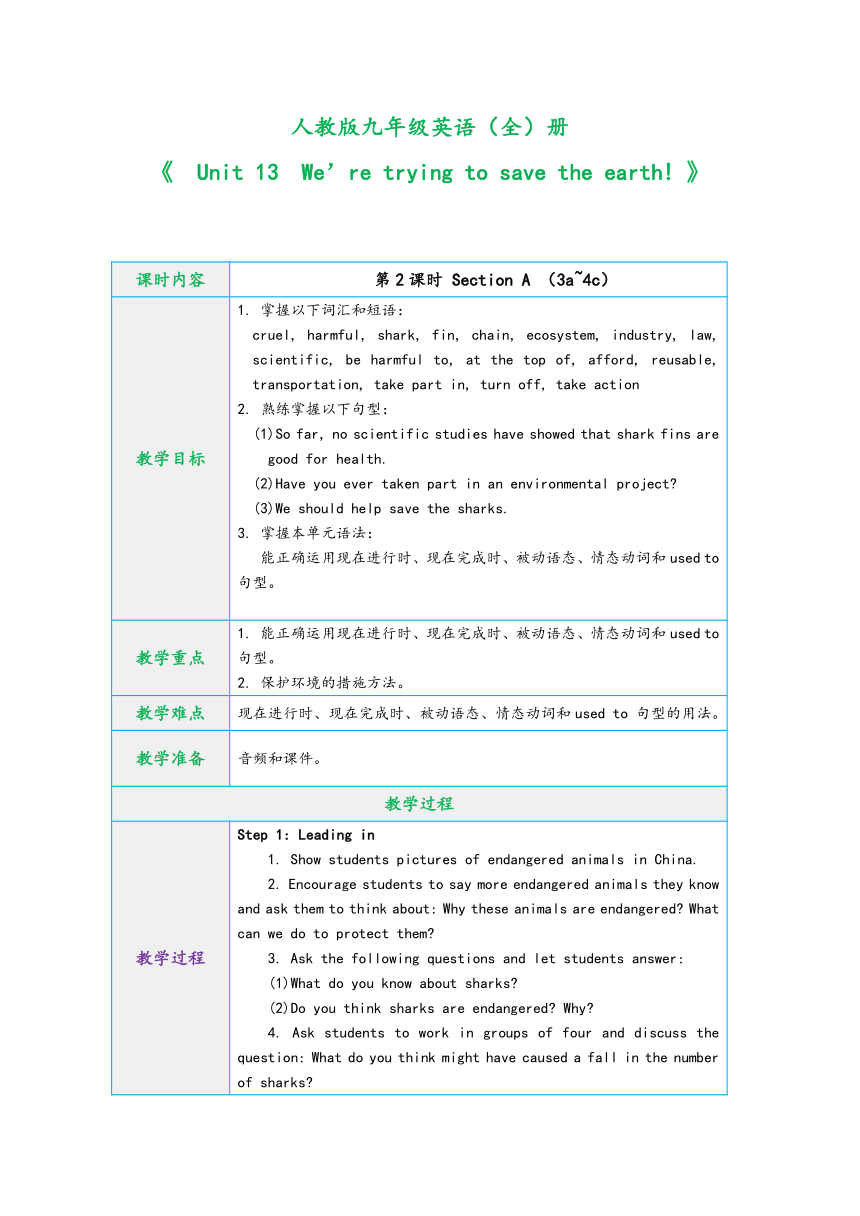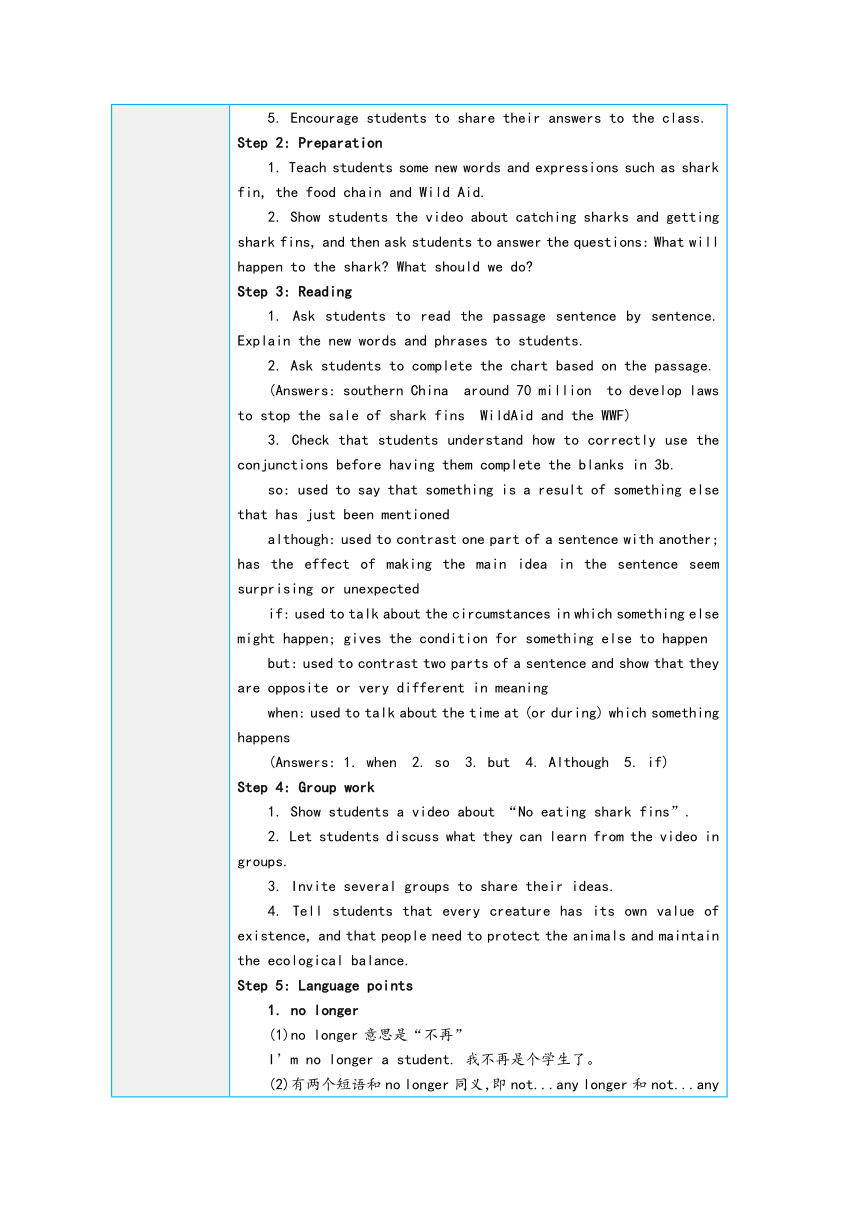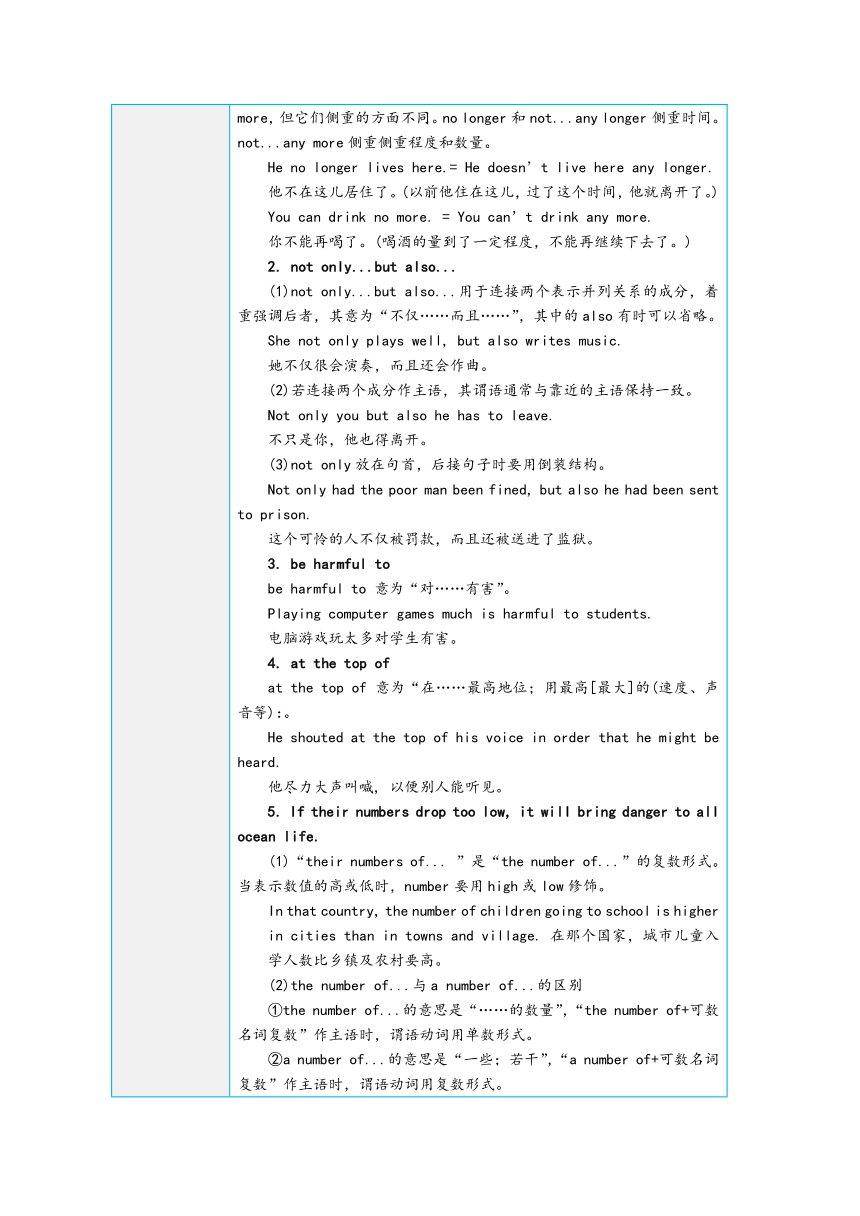Unit 13 We're trying to save the earth! 第2课时 Section A (3a~4c)表格式教学设计
文档属性
| 名称 | Unit 13 We're trying to save the earth! 第2课时 Section A (3a~4c)表格式教学设计 |

|
|
| 格式 | docx | ||
| 文件大小 | 20.4KB | ||
| 资源类型 | 教案 | ||
| 版本资源 | 人教新目标(Go for it)版 | ||
| 科目 | 英语 | ||
| 更新时间 | 2024-06-02 17:14:36 | ||
图片预览



文档简介
人教版九年级英语(全)册
《 Unit 13 We’re trying to save the earth! 》
课时内容 第2课时 Section A (3a~4c)
教学目标 1. 掌握以下词汇和短语: cruel, harmful, shark, fin, chain, ecosystem, industry, law, scientific, be harmful to, at the top of, afford, reusable, transportation, take part in, turn off, take action 2. 熟练掌握以下句型: (1)So far, no scientific studies have showed that shark fins are good for health. (2)Have you ever taken part in an environmental project (3)We should help save the sharks. 3. 掌握本单元语法: 能正确运用现在进行时、现在完成时、被动语态、情态动词和used to 句型。
教学重点 1. 能正确运用现在进行时、现在完成时、被动语态、情态动词和used to 句型。 2. 保护环境的措施方法。
教学难点 现在进行时、现在完成时、被动语态、情态动词和used to 句型的用法。
教学准备 音频和课件。
教学过程
教学过程 Step 1: Leading in 1. Show students pictures of endangered animals in China. 2. Encourage students to say more endangered animals they know and ask them to think about: Why these animals are endangered What can we do to protect them 3. Ask the following questions and let students answer: (1)What do you know about sharks (2)Do you think sharks are endangered Why 4. Ask students to work in groups of four and discuss the question: What do you think might have caused a fall in the number of sharks 5. Encourage students to share their answers to the class. Step 2: Preparation 1. Teach students some new words and expressions such as shark fin, the food chain and Wild Aid. 2. Show students the video about catching sharks and getting shark fins, and then ask students to answer the questions: What will happen to the shark What should we do Step 3: Reading 1. Ask students to read the passage sentence by sentence. Explain the new words and phrases to students. 2. Ask students to complete the chart based on the passage. (Answers: southern China around 70 million to develop laws to stop the sale of shark fins WildAid and the WWF) 3. Check that students understand how to correctly use the conjunctions before having them complete the blanks in 3b. so: used to say that something is a result of something else that has just been mentioned although: used to contrast one part of a sentence with another; has the effect of making the main idea in the sentence seem surprising or unexpected if: used to talk about the circumstances in which something else might happen; gives the condition for something else to happen but: used to contrast two parts of a sentence and show that they are opposite or very different in meaning when: used to talk about the time at (or during) which something happens (Answers: 1. when 2. so 3. but 4. Although 5. if) Step 4: Group work 1. Show students a video about “No eating shark fins”. 2. Let students discuss what they can learn from the video in groups. 3. Invite several groups to share their ideas. 4. Tell students that every creature has its own value of existence, and that people need to protect the animals and maintain the ecological balance. Step 5: Language points 1. no longer (1)no longer意思是“不再” I’m no longer a student. 我不再是个学生了。 (2)有两个短语和no longer同义,即not...any longer和not...any more,但它们侧重的方面不同。no longer和not...any longer侧重时间。not...any more侧重侧重程度和数量。 He no longer lives here.= He doesn’t live here any longer. 他不在这儿居住了。(以前他住在这儿,过了这个时间,他就离开了。) You can drink no more. = You can’t drink any more. 你不能再喝了。(喝酒的量到了一定程度,不能再继续下去了。) 2. not only...but also... (1)not only...but also...用于连接两个表示并列关系的成分,着重强调后者,其意为“不仅……而且……”,其中的also有时可以省略。 She not only plays well, but also writes music. 她不仅很会演奏,而且还会作曲。 (2)若连接两个成分作主语,其谓语通常与靠近的主语保持一致。 Not only you but also he has to leave. 不只是你,他也得离开。 (3)not only放在句首,后接句子时要用倒装结构。 Not only had the poor man been fined, but also he had been sent to prison. 这个可怜的人不仅被罚款,而且还被送进了监狱。 3. be harmful to be harmful to 意为“对……有害”。 Playing computer games much is harmful to students. 电脑游戏玩太多对学生有害。 4. at the top of at the top of 意为“在……最高地位;用最高[最大]的(速度、声音等):。 He shouted at the top of his voice in order that he might be heard. 他尽力大声叫喊, 以便别人能听见。 5. If their numbers drop too low, it will bring danger to all ocean life. (1)“their numbers of... ”是“the number of...”的复数形式。当表示数值的高或低时,number要用high或low修饰。 In that country, the number of children going to school is higher in cities than in towns and village. 在那个国家,城市儿童入学人数比乡镇及农村要高。 (2)the number of...与a number of...的区别 ①the number of...的意思是“……的数量”,“the number of+可数名词复数”作主语时,谓语动词用单数形式。 ②a number of...的意思是“一些;若干”,“a number of+可数名词复数”作主语时,谓语动词用复数形式。 Step 6: Grammar points 1. 现在进行时 (1)定义:表示说话时(瞬间)正在进行的动作,也表示目前或现阶段一直进行的动作。 (2)结构: be (am/is/ are) + v.-ing (3)标志词:Look, Listen, now, right now Look! The boy is crying. 看!那个男孩正在哭。 2. used to do与be used to doing used to do sth. 表示“过去常常做某事(而现在往往不做了)”,后接动词原形。be used to doing sth. 表示“习惯于做某事”。 I used to get up at six o’clock. 我过去常常六点钟起床。 Joe is used to drinking a cup of coffee every morning. 乔西关于每天早晨喝一杯咖啡。 3. 被动语态 (1)定义:表示主语是动作的承受者,即行为动作的对象的一种语态。 (2)结构:be + 过去分词 A new school was built last year. 去年,一所新学校被建了起来。 Our classroom is cleaned every day. 我们的教室每天都被打扫。 4. 现在完成时 (1)定义:表示动作已经完成, 但对现在造成影响; 或者表示从过去某一时间开始一直延续到现在并还可能持续下去的动作。 (2)结构: has/have + 过去分词 (3)标志词:already, yet, ever, never, since, for I haven’t finished my homework yet. 我还没有完成我的家庭作业。 5. 情态动词 (1)情态动词本身有一定的词义,表示说话人的情绪、态度或语气,但不能单独作谓语,只能与其他动词构成谓语。常见的有:can (could), may (might), must, need, shall (should), will (would)等。 (2)情态动词无人称和数的变化, 后接动词原形。否定式是在情态动词后面加not。个别情态动词有过去式形式, 可用来表达更加客气、委婉的语气。 Ken can climb up the trees like a koala. 肯能像考拉一样爬树。 You mustn’t play with fire. It is dangerous. 你不许玩火。那很危险。 Step 7: Practice 1. Work on 4a. Ask students to fill in the blanks with the correct forms of the verbs in brackets. (Answers: Have ... taken, helped, considered, had ... had, took, think, came, trying, wait) 2. Work on 4b. Ask students to fill in the blanks with the appropriate modal verbs from the box. (Answers: may / might, must / have to, can / should / could, can / could / should, have to, can / could / should, can / could, can / could, would / can / could) Step 8: Group work 1. Let students work in groups of four to make a list of things that people can do to help protect the environment. 2. When the groups have made their lists, conduct an open class discussion and elicit suggestions from each group. 3. Write the suggestions on the board, and then encourage students to comment on each other’s suggestions.
课堂作业 1. 复习今天学的新单词和表达方式。 2. 复述3a的课文。 3. 使用本节课所学的语法点,写出五点有利于保护你所在城市的环境的措施,并进行简要说明。
板书设计 Unit 13 We’re trying to save the earth! Section A(3a~4c)
Key words and phrases: harmful adj. → harm n. & v. reusable adj. → reuse v. cruel, shark, industry, law, scientific, be harmful to, at the top of, afford, transportation, take part in, turn off, take action Key sentences: 1. So far, no scientific studies have showed that shark fins are good for health. 2. Have you ever taken part in an environmental project 3. We should help save the sharks. Grammar: 1. 现在进行时:am/is/are doing 2. used to do sth. 过去常常做某事 be used to doing sth. 习惯于做某事 3. 被动语态:be + 过去分词 4. 现在完成时:has/have + 过去分词 5. 情态动词:无人称和数的变化 后接动词原形
教学反思 当我们学习语法时,我们应该知道学生是如何学习的,并让他们在不同的练习中练习。学生应该在不同的活动中练习语法。我们最好在演讲和阅读后给他们一些书面作品。
《 Unit 13 We’re trying to save the earth! 》
课时内容 第2课时 Section A (3a~4c)
教学目标 1. 掌握以下词汇和短语: cruel, harmful, shark, fin, chain, ecosystem, industry, law, scientific, be harmful to, at the top of, afford, reusable, transportation, take part in, turn off, take action 2. 熟练掌握以下句型: (1)So far, no scientific studies have showed that shark fins are good for health. (2)Have you ever taken part in an environmental project (3)We should help save the sharks. 3. 掌握本单元语法: 能正确运用现在进行时、现在完成时、被动语态、情态动词和used to 句型。
教学重点 1. 能正确运用现在进行时、现在完成时、被动语态、情态动词和used to 句型。 2. 保护环境的措施方法。
教学难点 现在进行时、现在完成时、被动语态、情态动词和used to 句型的用法。
教学准备 音频和课件。
教学过程
教学过程 Step 1: Leading in 1. Show students pictures of endangered animals in China. 2. Encourage students to say more endangered animals they know and ask them to think about: Why these animals are endangered What can we do to protect them 3. Ask the following questions and let students answer: (1)What do you know about sharks (2)Do you think sharks are endangered Why 4. Ask students to work in groups of four and discuss the question: What do you think might have caused a fall in the number of sharks 5. Encourage students to share their answers to the class. Step 2: Preparation 1. Teach students some new words and expressions such as shark fin, the food chain and Wild Aid. 2. Show students the video about catching sharks and getting shark fins, and then ask students to answer the questions: What will happen to the shark What should we do Step 3: Reading 1. Ask students to read the passage sentence by sentence. Explain the new words and phrases to students. 2. Ask students to complete the chart based on the passage. (Answers: southern China around 70 million to develop laws to stop the sale of shark fins WildAid and the WWF) 3. Check that students understand how to correctly use the conjunctions before having them complete the blanks in 3b. so: used to say that something is a result of something else that has just been mentioned although: used to contrast one part of a sentence with another; has the effect of making the main idea in the sentence seem surprising or unexpected if: used to talk about the circumstances in which something else might happen; gives the condition for something else to happen but: used to contrast two parts of a sentence and show that they are opposite or very different in meaning when: used to talk about the time at (or during) which something happens (Answers: 1. when 2. so 3. but 4. Although 5. if) Step 4: Group work 1. Show students a video about “No eating shark fins”. 2. Let students discuss what they can learn from the video in groups. 3. Invite several groups to share their ideas. 4. Tell students that every creature has its own value of existence, and that people need to protect the animals and maintain the ecological balance. Step 5: Language points 1. no longer (1)no longer意思是“不再” I’m no longer a student. 我不再是个学生了。 (2)有两个短语和no longer同义,即not...any longer和not...any more,但它们侧重的方面不同。no longer和not...any longer侧重时间。not...any more侧重侧重程度和数量。 He no longer lives here.= He doesn’t live here any longer. 他不在这儿居住了。(以前他住在这儿,过了这个时间,他就离开了。) You can drink no more. = You can’t drink any more. 你不能再喝了。(喝酒的量到了一定程度,不能再继续下去了。) 2. not only...but also... (1)not only...but also...用于连接两个表示并列关系的成分,着重强调后者,其意为“不仅……而且……”,其中的also有时可以省略。 She not only plays well, but also writes music. 她不仅很会演奏,而且还会作曲。 (2)若连接两个成分作主语,其谓语通常与靠近的主语保持一致。 Not only you but also he has to leave. 不只是你,他也得离开。 (3)not only放在句首,后接句子时要用倒装结构。 Not only had the poor man been fined, but also he had been sent to prison. 这个可怜的人不仅被罚款,而且还被送进了监狱。 3. be harmful to be harmful to 意为“对……有害”。 Playing computer games much is harmful to students. 电脑游戏玩太多对学生有害。 4. at the top of at the top of 意为“在……最高地位;用最高[最大]的(速度、声音等):。 He shouted at the top of his voice in order that he might be heard. 他尽力大声叫喊, 以便别人能听见。 5. If their numbers drop too low, it will bring danger to all ocean life. (1)“their numbers of... ”是“the number of...”的复数形式。当表示数值的高或低时,number要用high或low修饰。 In that country, the number of children going to school is higher in cities than in towns and village. 在那个国家,城市儿童入学人数比乡镇及农村要高。 (2)the number of...与a number of...的区别 ①the number of...的意思是“……的数量”,“the number of+可数名词复数”作主语时,谓语动词用单数形式。 ②a number of...的意思是“一些;若干”,“a number of+可数名词复数”作主语时,谓语动词用复数形式。 Step 6: Grammar points 1. 现在进行时 (1)定义:表示说话时(瞬间)正在进行的动作,也表示目前或现阶段一直进行的动作。 (2)结构: be (am/is/ are) + v.-ing (3)标志词:Look, Listen, now, right now Look! The boy is crying. 看!那个男孩正在哭。 2. used to do与be used to doing used to do sth. 表示“过去常常做某事(而现在往往不做了)”,后接动词原形。be used to doing sth. 表示“习惯于做某事”。 I used to get up at six o’clock. 我过去常常六点钟起床。 Joe is used to drinking a cup of coffee every morning. 乔西关于每天早晨喝一杯咖啡。 3. 被动语态 (1)定义:表示主语是动作的承受者,即行为动作的对象的一种语态。 (2)结构:be + 过去分词 A new school was built last year. 去年,一所新学校被建了起来。 Our classroom is cleaned every day. 我们的教室每天都被打扫。 4. 现在完成时 (1)定义:表示动作已经完成, 但对现在造成影响; 或者表示从过去某一时间开始一直延续到现在并还可能持续下去的动作。 (2)结构: has/have + 过去分词 (3)标志词:already, yet, ever, never, since, for I haven’t finished my homework yet. 我还没有完成我的家庭作业。 5. 情态动词 (1)情态动词本身有一定的词义,表示说话人的情绪、态度或语气,但不能单独作谓语,只能与其他动词构成谓语。常见的有:can (could), may (might), must, need, shall (should), will (would)等。 (2)情态动词无人称和数的变化, 后接动词原形。否定式是在情态动词后面加not。个别情态动词有过去式形式, 可用来表达更加客气、委婉的语气。 Ken can climb up the trees like a koala. 肯能像考拉一样爬树。 You mustn’t play with fire. It is dangerous. 你不许玩火。那很危险。 Step 7: Practice 1. Work on 4a. Ask students to fill in the blanks with the correct forms of the verbs in brackets. (Answers: Have ... taken, helped, considered, had ... had, took, think, came, trying, wait) 2. Work on 4b. Ask students to fill in the blanks with the appropriate modal verbs from the box. (Answers: may / might, must / have to, can / should / could, can / could / should, have to, can / could / should, can / could, can / could, would / can / could) Step 8: Group work 1. Let students work in groups of four to make a list of things that people can do to help protect the environment. 2. When the groups have made their lists, conduct an open class discussion and elicit suggestions from each group. 3. Write the suggestions on the board, and then encourage students to comment on each other’s suggestions.
课堂作业 1. 复习今天学的新单词和表达方式。 2. 复述3a的课文。 3. 使用本节课所学的语法点,写出五点有利于保护你所在城市的环境的措施,并进行简要说明。
板书设计 Unit 13 We’re trying to save the earth! Section A(3a~4c)
Key words and phrases: harmful adj. → harm n. & v. reusable adj. → reuse v. cruel, shark, industry, law, scientific, be harmful to, at the top of, afford, transportation, take part in, turn off, take action Key sentences: 1. So far, no scientific studies have showed that shark fins are good for health. 2. Have you ever taken part in an environmental project 3. We should help save the sharks. Grammar: 1. 现在进行时:am/is/are doing 2. used to do sth. 过去常常做某事 be used to doing sth. 习惯于做某事 3. 被动语态:be + 过去分词 4. 现在完成时:has/have + 过去分词 5. 情态动词:无人称和数的变化 后接动词原形
教学反思 当我们学习语法时,我们应该知道学生是如何学习的,并让他们在不同的练习中练习。学生应该在不同的活动中练习语法。我们最好在演讲和阅读后给他们一些书面作品。
同课章节目录
- Unit 1 How can we become good learners.
- Section A
- Section B
- Unit 2 I think that mooncakes are delicious!
- Section A
- Section B
- Unit 3 Could you please tell me where the restroom
- Section A
- Section B
- Unit 4 I used to be afraid of the dark.
- Section A
- Section B
- Unit 5 What are the shirts made of?
- Section A
- Section B
- Review of Units 1-5
- Unit 6 When was it invented?
- Section A
- Section B
- Unit 7 Teenagers should be allowed to choose their
- Section A
- Section B
- Unit 8 It must belong to Carla.
- Section A
- Section B
- Unit 9 I like music that I can dance to.
- Section A
- Section B
- Unit 10 You're supposed to shake hands.
- Section A
- Section B
- Review of Units 6-10
- Unit 11 Sad movies make me cry.
- Section A
- Section B
- Unit 12 Life is full of the unexpected
- Section A
- Section B
- Unit 13 We're trying to save the earth!
- Section A
- Section B
- Unit 14 I remember meeting all of you in Grade 7.
- Section A
- Section B
- Review of Units 11-14
